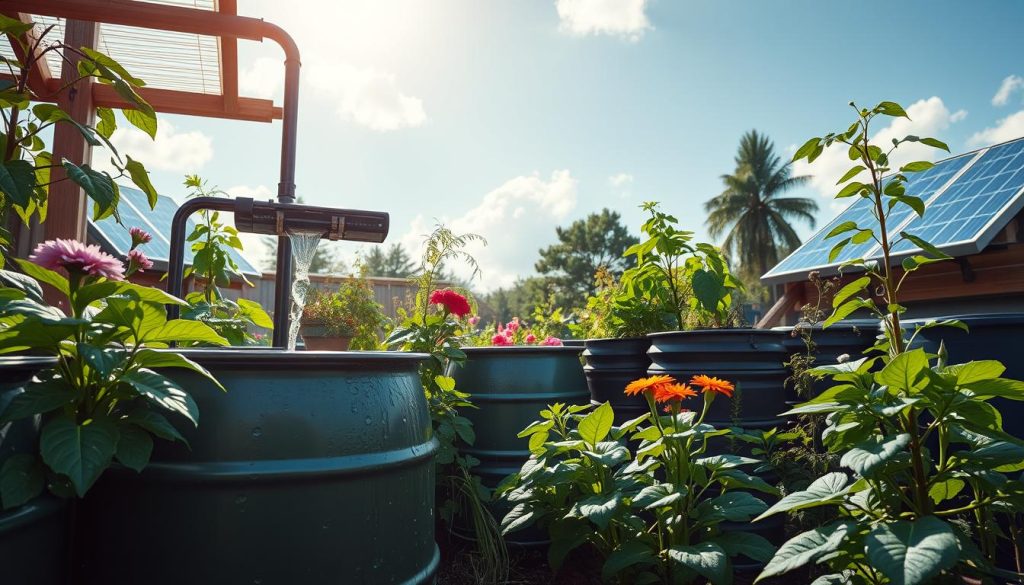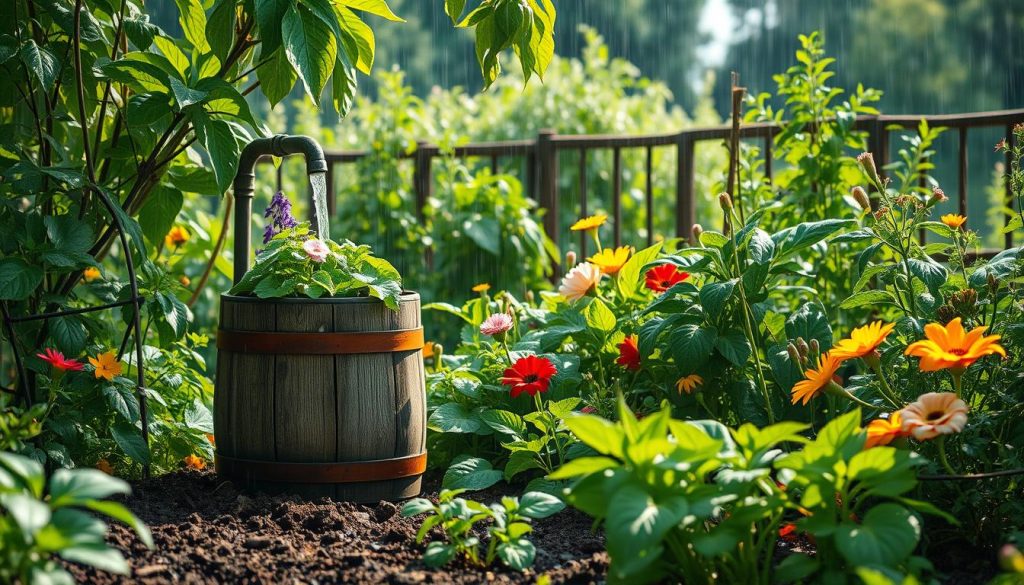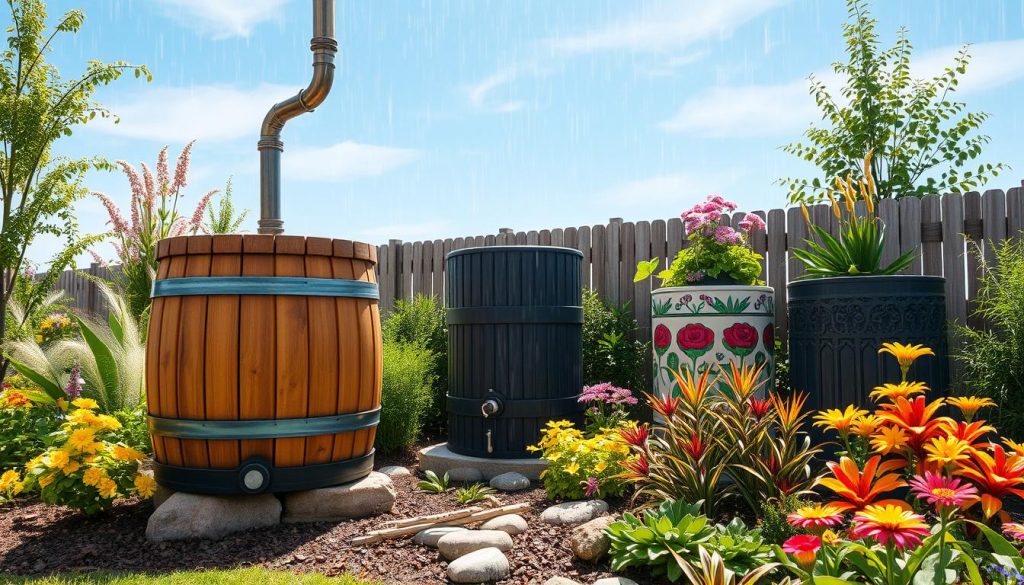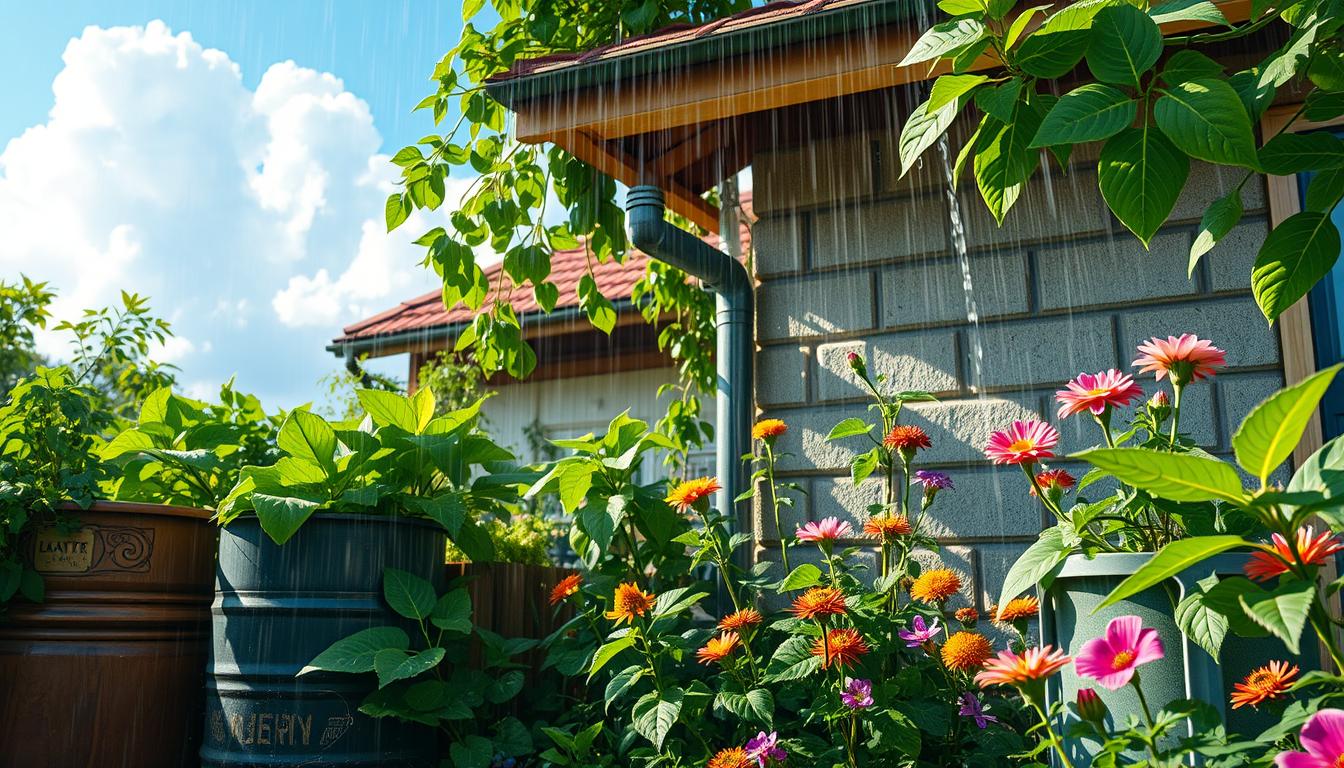I’m excited to share my knowledge on rainwater harvesting for gardens. It’s a simple yet effective way to make your garden sustainable. By using a garden rainwater collection system, you can cut down on water bills. Plus, your plants will get the nutrients they need to grow well.
As a gardener, I’ve found that rainwater harvesting is great for saving water and helping plants grow. With a good rainwater harvesting system, you can store rainwater for later use. This means you use less municipal water and save money.
In this article, I’ll show you how to create a thriving garden with rainwater harvesting. We’ll cover everything from the basics to advanced techniques. I’ll share my best tips to help you start your journey to a sustainable, water-efficient garden.
What is Rainwater Harvesting?
Rainwater harvesting is a simple way to collect and store rainwater. It’s great for watering plants and washing cars. This method is key for managing water in gardens, offering a natural and sustainable water source.
Collecting rainwater helps us use less municipal water and saves money on bills. It also cuts down on stormwater runoff. This runoff can pollute our waterways and harm fish and other aquatic life.
The Basics of Rainwater Harvesting
The basics of rainwater harvesting include collecting rain from roofs, gutters, and downspouts. Then, we store it in tanks or cisterns. Here’s how to start:
- Install a rainwater collection system, including a roof catchment, gutters, and downspouts
- Choose a suitable storage tank or cistern
- Connect the storage tank to a distribution system, such as a hose or irrigation pipe
Importance for Gardening
Rainwater harvesting is crucial for gardening. It gives plants a natural and sustainable water source. Using rainwater for gardening cuts down on water bills and makes our gardens more eco-friendly. Here is an image of a rainwater harvesting system:

| Benefits of Rainwater Harvesting | Description |
|---|---|
| Reduced water bills | By collecting and storing rainwater, we can reduce our reliance on municipal water supplies |
| Eco-friendly garden water management | Rainwater harvesting provides a natural and sustainable source of water for plants |
Benefits of Rainwater Harvesting for Gardens
Rainwater harvesting has many benefits for gardeners. It helps us use less municipal water. This means we can save money on water bills and garden more sustainably. One big plus is the money we save.
Cost Savings on Water Bills
Using rainwater for gardening cuts down our water bills. With DIY garden rainwater harvesting, we can collect rainwater for free. This saves us money and helps conserve water, which is very important.
Improved Plant Health and Growth
Rainwater is full of nutrients and minerals that plants need. Using it for gardening makes our plants healthier and grow better. This makes our gardens more vibrant and alive. Here are some tips to start using rainwater for your garden:
- Collect and store rainwater in a designated container
- Use a first flush device to divert debris and contaminants
- Install a filtration system to ensure clean water for your plants

How to Set Up a Rainwater Harvesting System
Setting up a rainwater harvesting system is a smart way to collect rainwater for your garden. You’ll need a rainwater tank, gutters, and downspouts. The size of your roof and local rainfall will help decide your tank’s size.
To start, think about these when picking your gear:
- Rainwater tank size and material
- Gutter and downspout type and size
- First flush device to divert debris
Choosing the Right Equipment
When picking your equipment, look for quality and durability. A good system makes garden irrigation with rainwater efficient and effective.

Installation Steps for Beginners
Installing a rainwater system is easy. First, connect your gutters and downspouts to the tank. Then, add a first flush device to keep out debris. With the right tools and setup, you’ll save on water bills and help your garden.
Types of Rainwater Collection Systems
Choosing the right rainwater collection system is key for your garden. There are many options, each with its own benefits and drawbacks. We’ll look at rain barrels and cisterns to help you pick the best for your garden.
Rain Barrels for Small Gardens
Rain barrels are perfect for small gardens. They catch rainwater from downspouts. Made from plastic or wood, they come in sizes from 30 to 100 gallons. They’re easy to set up and need little care.
Cisterns for Larger Landscapes
Cisterns are big tanks that hold thousands of gallons of water. They’re great for big gardens. Made from concrete or steel, they can be placed above or below ground. They’re a solid choice for a steady water supply for irrigation and more.
Here’s a quick look at rain barrels and cisterns:
| System | Size | Material | Installation |
|---|---|---|---|
| Rain Barrels | 30-100 gallons | Plastic or wood | Easy installation under downspouts |
| Cisterns | Thousands of gallons | Concrete or steel | Above or below ground installation |

Best Locations for Rainwater Collection
Collecting rainwater is all about the right spot. As someone who loves sustainable garden water solutions, I’ve found that your roof matters a lot. I’ll talk about the best places for rainwater collection and how different roofs affect it.
For eco-friendly water saving, think about your roof’s size, shape, and material. A bigger roof means more water, but the shape and material matter too. They help the water flow well into your system.
Roof Types and Their Impact
Roofs can change how much and how well you collect rainwater. Steeper roofs catch more water than flat ones. Also, certain materials like asphalt shingles or metal work better than others like clay tiles or wood shakes.
Ideal Placement of Collection Systems
To get the most from rainwater collection, pick the right spot. Look for places with lots of rain, like near downspouts or in low spots. Using a first flush device can also help by keeping out debris and contaminants.
Here are some tips for the best spot for your collection system:
- Put your system near a downspout to catch roof rainwater.
- Choose a spot with little shade to stop algae and bacteria growth.
- Use a screen or mesh to block debris and keep your system clean.
Maintenance of Rainwater Systems
Keeping your rainwater harvesting system in top shape is key. This means regular checks and cleanings. Also, seasonal maintenance tips help your system handle extreme weather.
For garden water management, inspect your rainwater systems often. This prevents clogs and keeps the water clean. Here are some tips for upkeep:
Regular Checks and Cleanings
- Inspect the roof and gutters to ensure they are clear of debris
- Check the screens and filters to ensure they are clean and functioning properly
- Test the water quality to ensure it’s safe for use in your garden
Seasonal Maintenance Tips
To get your rainwater systems ready for harsh weather, follow these tips:
- Winter: Insulate the pipes and tanks to prevent freezing
- Summer: Check the system for signs of overheating and ensure proper ventilation
By sticking to these maintenance tips, your rainwater harvesting system will work well. It will give you a steady water supply for your garden.
| Maintenance Task | Frequency |
|---|---|
| Inspect roof and gutters | Monthly |
| Check screens and filters | Quarterly |
| Test water quality | Bi-annually |
How to Filter Rainwater for Gardening
Filtering rainwater is key to remove debris and contaminants that can harm plants. It’s a vital step in DIY garden rainwater harvesting. I’ll cover simple and advanced ways to filter rainwater for your garden.
There are many ways to filter rainwater, from simple to advanced. Here are some common methods:
- Using a first flush device to remove debris and sediment
- Installing a screen filter to catch larger particles
- Implementing a sediment filter to remove smaller particles
- Using a UV filter to kill bacteria and other microorganisms
Simple Filtration Methods
Simple methods are easy to set up and need little equipment. They’re great for small gardens or beginners in DIY garden rainwater harvesting.
Advanced Filtration Solutions
Advanced solutions are more complex and need more equipment. They offer better filtration and are best for larger gardens or those seeking top-quality water for plants.
Using these methods ensures your rainwater is clean and safe for your garden. You’ll enjoy lower water bills and healthier plants.
| Filtration Method | Description |
|---|---|
| First Flush Device | Removes debris and sediment from the water |
| Screen Filter | Catches larger particles and debris |
| Sediment Filter | Removes smaller particles and sediment |
| UV Filter | Kills bacteria and other microorganisms |
Understanding Local Regulations
Before you start a rainwater harvesting system, know the local rules and permits needed. This step helps you avoid fines or problems. It’s key to follow local laws for a safe and working system.
Garden rainwater systems must follow certain rules. To be sure you’re meeting these, look into your area’s laws. Here are important points to think about:
- Permits: Find out if you need a permit for your system.
- Water quality: Make sure your system meets local water standards to prevent contamination.
- System size: Check if there are size limits for your system.
Permits and Requirements
Permits and rules for rainwater systems differ by place. Always check with your local government for what’s needed. Some places might need a permit, while others won’t.
Best Practices for Compliance
To follow local rules, use best practices for rainwater harvesting. This means regular upkeep, correct setup, and watching your system. These steps help keep your system safe and legal.
Knowing local rules and using best practices lets you enjoy rainwater harvesting. Always check with your local government for specific needs and rules.
| Location | Permit Required | System Size Limit |
|---|---|---|
| Urban areas | Yes | 1,000 gallons |
| Rural areas | No | No limit |
Tips for Maximizing Collecting Rainwater
To get the most out of rainwater collection, you need a solid plan. Design your garden to use rainwater wisely. This way, you’ll save on water bills and have a low-maintenance garden.
Planting and arranging your garden smartly is key. Choose plants that need little water and place them for best water use. Also, make sure your gutters work well to catch and store rainwater.
Strategic Planting and Layouts
When planning your garden, think about a few things. These include:
- Choosing plants that fit your climate and soil
- Arranging plants for efficient water use
- Using mulch to cut down on evaporation and runoff
Utilizing Gutters Effectively
Getting the most from your gutters is important. You can do this by:
- Installing a rainwater harvesting system
- Keeping your gutters clean of debris
- Using downspouts to direct water to your collection system
By using these tips, you can make the most of rainwater. Your garden will flourish and be kind to the environment.
| Benefits of Rainwater Harvesting | Description |
|---|---|
| Cost Savings | Reduced water bills and lower maintenance costs |
| Improved Plant Health | Healthier plants and reduced risk of disease |
| Increased Water Supply | Additional water source for gardening and other non-potable uses |
Integrating Rainwater with Irrigation Systems
As a gardener, I’ve found that using rainwater with my irrigation system helps a lot. It cuts down my water bills and helps my plants grow better. Drip irrigation is great because it waters the roots directly, saving water and preventing waste.
Connecting rainwater systems to drip irrigation is easy and smart. It makes watering plants efficient. Some good things about this combo include:
- Reduced water waste
- Increased plant growth and health
- Lower water bills
Drip Irrigation Compatibility
Drip irrigation works well with rainwater because it waters slowly and steadily. This is perfect for plants that need consistent moisture, like veggies and fruits.
Automatic Timers for Efficiency
Automatic timers help make watering plants with rainwater even better. They water plants at the best times, saving water and effort. This is great for gardeners who are always busy.
Common Mistakes to Avoid
When setting up a rainwater harvesting system for your garden, knowing common mistakes is key. Not keeping up with maintenance can lead to clogged gutters and dirty water. This can make your system less effective. By avoiding these mistakes, you can make sure your system works well and gives you clean water for your garden.
Overlooking Maintenance Needs
Keeping your rainwater harvesting system in good shape is important. You should check gutters and downspouts for blockages, clean the roof catchment, and look for damage or contamination in the storage tank. Regular maintenance helps keep your rainwater clean and your system working well.
Choosing the Wrong System
Picking the right rainwater harvesting system is crucial for your garden. Think about your roof size, gutter type, and how much water you need. Talking to a professional can help you find the best system for your garden. This way, you can use rainwater efficiently and save water.
Knowing these common mistakes and how to avoid them helps you set up a good rainwater harvesting system. This system can be a sustainable water source for your garden. It reduces your need for city water and helps the environment.
Encouraging Biodiversity with Rainwater Harvesting
Rainwater harvesting is more than just saving water for your garden. It also helps support local biodiversity. By using sustainable water solutions, you can attract native plants, birds, bees, and butterflies to your garden.
Native Plants and Water Needs
Choose native plants for your garden that fit the local climate. They need less care and water, perfect for a rainwater-fed garden. Native plants make your garden beautiful and help native pollinators and wildlife.
Creating Habitat Areas in Gardens
Add features to your garden to attract different species. You can build a pond or birdbath, leave areas for insects, or install birdhouses and bee hotels. These will help a variety of local animals, improving your garden’s ecosystem.

